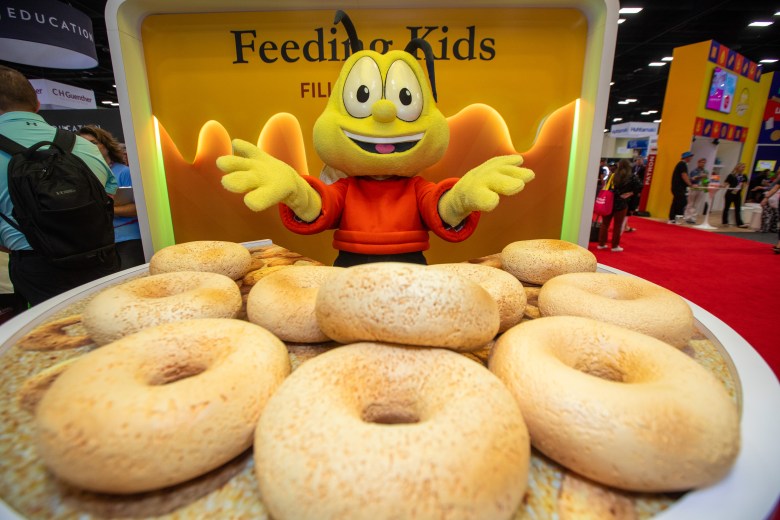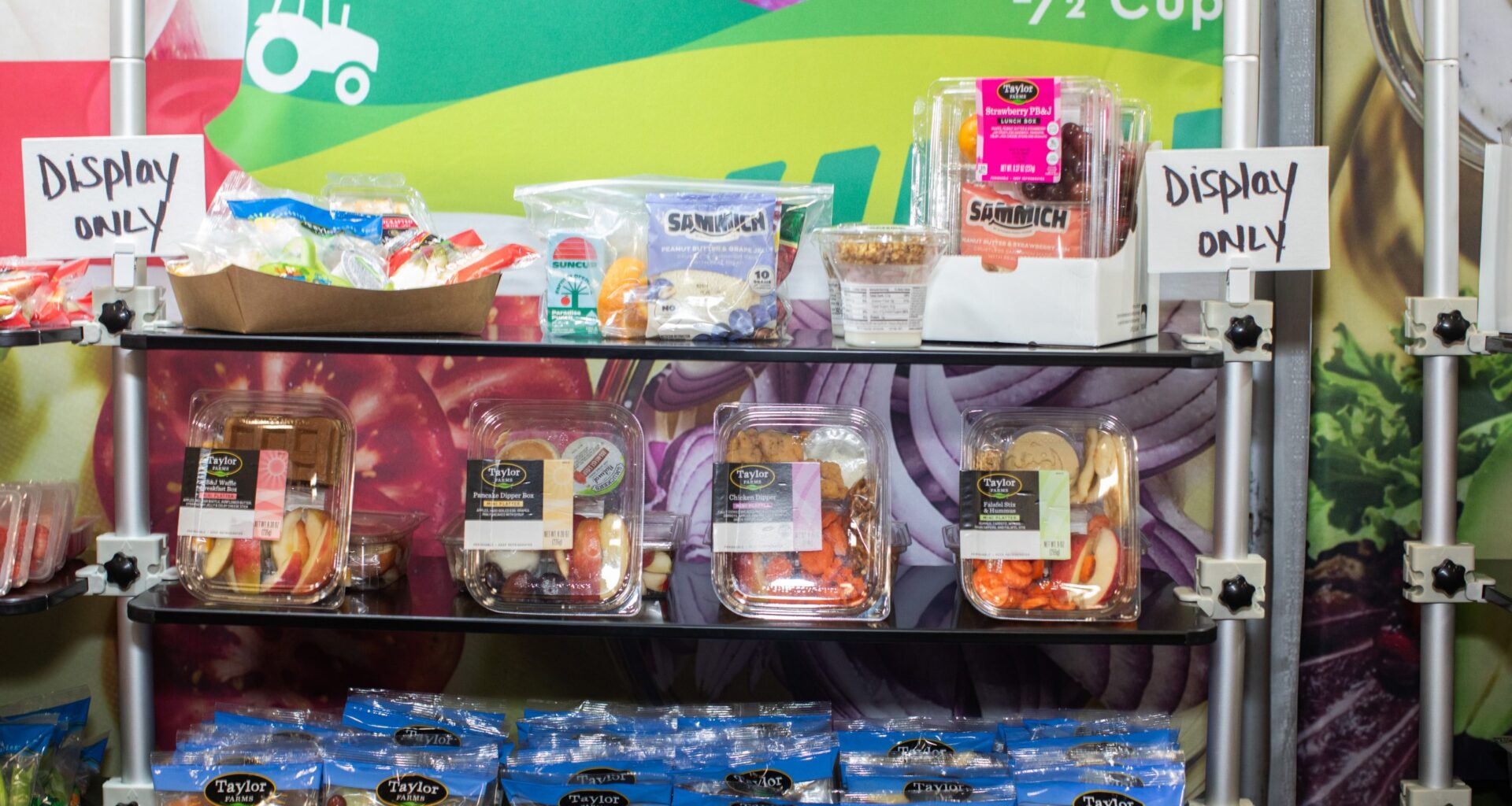Thousands of school nutritionists from across the country swooped into San Antonio this week for a conference all about one thing: what K-12 students eat.
Two local experts guided the Report through food taste-testing, federal nutrition requirements and one school district’s famous enchiladas.
Sharon Glosson, the executive director of school nutrition at North East Independent School District, attends the School Nutrition Association conferences to garner school lunch menu ideas and see what’s new on the market.
When scoping out vendors for NEISD, Glosson said the most important part is making sure they produce foods that meet federal nutrition requirements, while also being appetizing to kids.
 Public schools will have to cut back on added sugars in milk, yogurt and cereal for the upcoming 2025-26 school year to meet USDA regulations. Credit: Vincent Reyna for the San Antonio Report
Public schools will have to cut back on added sugars in milk, yogurt and cereal for the upcoming 2025-26 school year to meet USDA regulations. Credit: Vincent Reyna for the San Antonio Report
“One of the biggest things with trying to build the meals is trying to get fresh food,” Glosson said while walking through the conference’s exhibition hall, where nearly 1,000 vendors lined up to offer food samples ranging from pre-sliced apples to Orange Chicken.
The more that cafeterias can cut down on sodium, sugar and labor costs, the better, Glosson added. Specific requirements change for each grade level, but the U.S. Department of Agriculture requires that every student be served fruits, vegetables, grains, meat or a meat alternative, and milk every day for schools to be reimbursed for those meals.
Nutrition regulations can also change each school year. By the 2026-27 school year, cafeterias will have to cut way back on the amount of added sugars students consume every week. Previously, there were no limits on the amount of added sugars, only limits on overall sugar.
Kicking off this process on July 1, USDA started requiring schools to cut back on added sugars in milk, yogurt and cereal for the upcoming school year.
East Central ISD’s elementary school menus have already been adjusted to less than 10% of a weekly average of added sugars for the upcoming school year. Ashley Robbins, the district’s dietician and menu planner, led a workshop during the conference showing other school nutritionists how to create menus that comply with the new regulations and how to market them to students.
“It’s doable, even with lower labor, even with rising costs there’s ways to be able to do that,” Robbins said.
 Ashley Robbins, child nutrition dietitian for East Central ISD, meets with groups of attendees to create a breakfast menu consisting of new nutritional standards in the Henry B. Gonzalez Convention Center. Credit: Vincent Reyna for the San Antonio Report
Ashley Robbins, child nutrition dietitian for East Central ISD, meets with groups of attendees to create a breakfast menu consisting of new nutritional standards in the Henry B. Gonzalez Convention Center. Credit: Vincent Reyna for the San Antonio Report
For Robbins, it’s not just about what her students eat, but also what environment they eat in. Robbins recently spearheaded efforts to win ECISD a $50,000 grant from the School Nutrition Foundation for outdoor eating furniture.
The furniture, which Robbins will get to design and choose herself, will go toward the district’s two high schools where she hopes having outdoor eating will help with students’ mental health.
The biggest challenge for Robbins, however, is having meal options students actually want to eat.
For inspiration, she often drives around the school district to get a sense for the kinds of restaurants her students frequent — usually coffee and fast-food chains.
“I just want to make sure that I’m offering it to them in the healthiest version possible.”
This is where school nutritionists can get creative. A breakfast favorite over at NEISD is a ham and swiss croissant produced by San Antonio-based Buena Vista Foods, which also makes an “adult” version of the croissant for a national coffee shop chain.
The school version is 51% whole grain, with low sodium ham and “government cheese,” a term that refers to a type of processed cheese distributed by the government in the 80s.
While government cheese can get a bad rap, it’s a way for school nutritionists like Glosson and Robbins to use federal reimbursement dollars to buy locally farmed and produced foods.
“Government cheese is not a negative,” Buena Vista regional sales manager Graham Smith said. “There’s swiss, there’s mozzarella and many different ones.”
And as student palettes expand through globalization, there’s more room to have fun in the cafeteria kitchen while maintaining healthy standards, Glosson added.
 Tarah Dane, brand manager of Palmetto Gourmet Foods, explains the idea of Woodles, a ramen that meets nutritional requirments for school lunches. Credit: Vincent Reyna for the San Antonio Report
Tarah Dane, brand manager of Palmetto Gourmet Foods, explains the idea of Woodles, a ramen that meets nutritional requirments for school lunches. Credit: Vincent Reyna for the San Antonio Report
That’s where vendors can come in and offer more diverse options like low-sodium pupusas, carne al pastor, Asian-style sauces and even ramen. Instant woodles, or wheat noodles, recently hit the school lunch market, building a niche as one of the trendiest school food items, Glosson said.
Many kids bring in cups of instant ramen to school already, but now public schools can offer it through the national school lunch program. All school cafeterias have to do is add hot water and top it off with a serving of meat and vegetables.
 Taylor Thompson, chef and culinary development coordinator for NEISD begins a panel demonstrating how the decades popular school enchiladas are made. Credit: Vincent Reyna for the San Antonio Report
Taylor Thompson, chef and culinary development coordinator for NEISD begins a panel demonstrating how the decades popular school enchiladas are made. Credit: Vincent Reyna for the San Antonio Report
Regardless of whatever the hottest school lunch trends are, NEISD will likely never abandon their San Antonio roots: Enchilada Wednesdays.
The NEISD nutrition team hosted its own workshop during the conference with a live cooking demonstration of the district’s “flagship dish,” according to district chef and culinary coordinator Taylor Thompson.
Thompson shared the school’s recipe: a mix of American and mozzarrella cheese rolled in steamed corn tortillas, smothered in enchilada sauce made from ground spices and thickened with a roux, topped with more cheese, baked in the oven and topped with beef chili on request.
“The skill of hand rolling enchiladas is something we take pride in,” he said.
